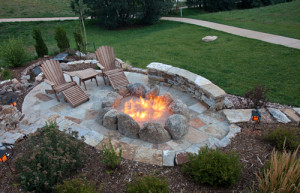Fire Pits are a Hot Trend for Backyards Are they covered?

While a fire pit will certainly improve the functionality of your outdoor living area there are risks that you should be aware of before breaking ground on your new fire pit.
Winter is getting closer every day but just because the temperatures are dropping and the snow will be flying doesn’t mean you have to close up your backyard. A fire pit can make a cold evening an enjoyable adventure and according to landscaping experts, fire pits are gaining in popularity and are a hot choice for outdoor living design.
While a fire pit will certainly improve the functionality of your outdoor living area there are risks that you should be aware of before breaking ground on your new fire pit.
Your first call should be to your homeowner’s association if your living in a development governed by an HOA. Some HOA’s do not allow fire pits at all or have strict rules regarding placement and the type of pit allowed on a property. It pays to check before building, and to stay in compliance with your neighborhood rules.
You should also check with your local fire officials regarding fire pits. Local fire codes vary and some fire-prone areas may ban fire pits altogether while others will have regulations regarding placement and even months that they can be used. Again, be sure to have a completely understanding of the rules and stay in compliance with local ordinances.
If you are installing a permanent fire pit you will have a number of options available to you. Everything from hiring a professional to do it yourself kits available from your local home improvement store are an option and budgets can range from a few hundred dollars well into the thousands for an elaborate structure.
It pays to decide what type of pit you want and set a budget before you get started. Decide whether you have the necessary skills, time and patience to do it yourself or if a professional might be the better choice. One of the most important decisions will be the placement of the pit.
Experts recommend placing your fire pit at least 10 feet from your home and farther if possible. It is also important not to build it under a tree canopy or close to other structures on your property (a garage, shed or barn) that could easily burn.
If your fire pit will require you to dig into the ground be sure to have your local utilities come out and mark out their lines and pipes. The last thing you want is a fire pit next to an electrical or gas line.
Am I Covered?
The big question now is whether or not all this additional risk (make no mistake, an open fire is always a risk) is covered by your homeowners policy.
Luckily, in almost all cases you should be covered but it is important to review your policy limits to make sure you have enough protection in the event you burn down your house, or even worse, your neighbors.
According to industry experts, a portable fire pit would usually be considered a personal belonging and any damages caused by it would fall under your personal property coverage on your policy. On the other hand, a permanent pit would often be considered a separate unattached structure and would be covered under a different portion of your policy.
Unattached structures are typically only covered for a certain percentage of the amount of insurance you have on your entire home. In most cases it runs about 10 percent of the policy value so if your coverage limits were $150,000 the total coverage for all unattached structures on your property would be $15,000.
While this would usually be enough to cover your fire pit, if the resulting fire also burned down a garage, shed or barn you could find yourself on the hook for a substantial portion of the rebuilding costs.
You should also review your liability limits as well to make sure you have enough coverage in the event you accidentally burn down your neighbor’s house. Experts advise talking to your agent regarding your coverage levels before starting your fire pit project to review your options and make sure you are completely protected should the worst happen.
In some wildfire prone areas, prior notice may be a requirement for coverage so call your home insurance agent before starting your project. Once your fire pit is complete be sure to practice fire safety. Always have a fire extinguisher or hose nearby and avoid starting a fire in dry or high wind situations.
